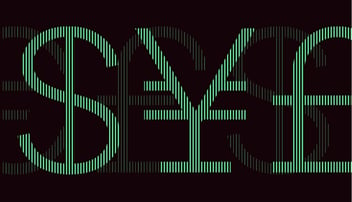Gain an overview of the latest developments on the currency market and anticipate fluctuation risks.
EUR/USD
High: 1.1704 Low: 1.1524 Change: -0.06%
As expected, the European Central Bank meeting was not a particularly important one. The real date for the EUR/USD pair is the US Federal Reserve meeting on 2-3 November. There is consensus within the US central bank on the need to normalise monetary policy by reducing asset purchases (tapering). Every month, the central bank buys back an average of $120 billion of assets on the financial markets. From mid-November or early December at the latest, the volume of asset purchases should decrease by USD 15 billion per month. At this rate, the central bank should end its asset purchase programme from June 2022. The foreign exchange market anticipates that a first rate hike could occur in September 2022, if inflation remains high. The upcoming meeting is important. Any comment on the course of inflation will be closely scrutinised. We should expect a lot of volatility in USD pairs on the evening of Wednesday, 3 November.
EUR/GBP
High: 0.8662 Low: 0.8396 Change: -1.56%
The EUR/GBP has definitively broken out of its summer range of 0.85-0.86. The pound strengthened by 1.56% month-on-month in October. The expectation that the Bank of England (BoE) will raise rates as early as the meeting on Thursday, 4 November is the main factor behind the strengthening of the GBP. With inflationary pressures building and possibly exceeding 5% year-on-year at the beginning of next year, the FX market is anticipating that the central bank could raise its main policy rate by 15 to 25 basis points in November. It is very rare for the Bank of England to decide to act before the US Federal Reserve. But the jump in UK inflation leaves the BoE with little choice. Caution: the rise in rates is not guaranteed. We will have to be vigilant. The only certainty we have at this stage is that there will be volatility in the GBP pairs in the first week of November.
EUR/JPY
High: 133.49 Low: 128.32 Change: +2.53%
In our view, the euro’s rise against the Japanese yen in October was mainly due to a technical rebound. The short-term outlook for the global economy, and particularly the course of inflation, should logically lead FX market operators to retreat to safe haven assets (US dollar, Swiss franc and of course the Japanese yen). This is called the flight to quality. A return of the pair to the 130-129 area cannot be ruled out in the short term. On the monetary policy front, Japan remains on autopilot. We do not expect a change in discourse from the central bank in the coming months.
EUR/CHF
High: 1.0887 Low: 1.0560 Change: -2.07%
The EUR/CHF reached an 11-month low in late October on the foreign exchange market. The Swiss franc also strengthened noticeably against the US dollar, for example. Forex market operators’ concerns about the course of inflation are prompting their retreat into safe haven assets, including the Swiss franc. Given the uncertainties in the global economy, the Swiss franc is likely to continue to register gains in the short term. Since mid-September, the Swiss currency has gained almost 2.6% against the euro. The Swiss National Bank, which closely monitors the CHF, has stayed away from the market since the return after the summer. There was just one small intervention in FX last week - the first in six weeks. We doubt at this stage that Swiss Central Bank intervention on the forex market will intensify.
EUR/CAD
High: 1.4843 Low: 1.4293 Change: -2.49%
The EUR/CAD pair was subject to volatility. At the end of October, the Canadian dollar rose to a 20-month high against the euro. The Bank of Canada’s more hawkish (meaning pro-tightening) tone was the main driver behind the rise. In addition, commodity prices have risen significantly over the past few weeks. Taking the forex market by surprise, the Canadian central bank ended its QE (Quantitative Easing) asset purchase programme and, more importantly, indicated that a first rate hike is likely around mid-2022. According to market consensus, the rate hike could come as early as March or April next year. All indications are that the Canadian dollar’s rise against the euro is still in its infancy. There are still a few forex market operators who are bearish on the Canadian dollar, but this is unlikely to last. When these positions are closed, we can expect to see a very strong acceleration of the Canadian currency.
EUR/AUD
High: 1.6184 Low: 1.5345 Change: -3.85%
The direction of the EUR/AUD pair was clear in October. The single currency depreciated by almost 3.85% month-on-month. This mainly reflected an appreciation of the Australian dollar. Two factors were of crucial importance: the continued rise in commodity prices in an increasingly constrained economic environment, and the prospect of an earlier than expected rate hike by the Australian central bank. The forex market expects a first rate hike in mid-2022, potentially in September or November, compared to 2023 previously. Again, the intensification of inflationary pressures is prompting an acceleration of the monetary policy normalisation timetable. Given the strong rise in the AUD in recent weeks, we cannot rule out profit taking in the short term.
EUR/CNH
High: 7.5006 Low: 7.3912 Change: -0.80%
The Chinese currency remains strong. This is linked to the desire of the authorities in Beijing to secure energy supplies at any cost. A strong currency reduces the cost of energy imports. In addition, it should be noted that the downturns on the Chinese property market seem to have a very limited effect on the CNH, as one might expect. As long as the energy crisis persists, the EUR/CNH is likely to continue its depreciation.
EUR/HUF
High: 367.15 Low: 355.26 Change: +0.22%
In our view, the euro’s month-on-month rise against the HUF is explained by both a technical rebound and uncertainty regarding the pace of monetary policy tightening in Hungary. But this last factor is only likely to have a short-term impact. The Hungarian central bank has been among the most aggressive central banks on emerging markets in countering inflationary pressures. Further rate hikes are likely. Their scale, however, is uncertain. At the end of October, the deputy governor of the central bank Barnabas Virag indicated that the country is facing a prolonged period of high inflation and that by the end of the year, further rate hikes are likely, potentially around 15 basis points each time.
USD/HUF
High: 316.52 Low: 305.39 Change: +0.44%
In this case, the appreciation of the USD/HUF is due to a very simple phenomenon: the flight to quality. In a more uncertain economic world, marked by higher inflation in many countries, the US dollar looks like a safe haven. Investors around the world are taking their money out of risky assets and putting it into the US market, traditionally in Treasury bills. This supports the dollar exchange rate. This phenomenon is very likely to continue in the short term.
Topics






